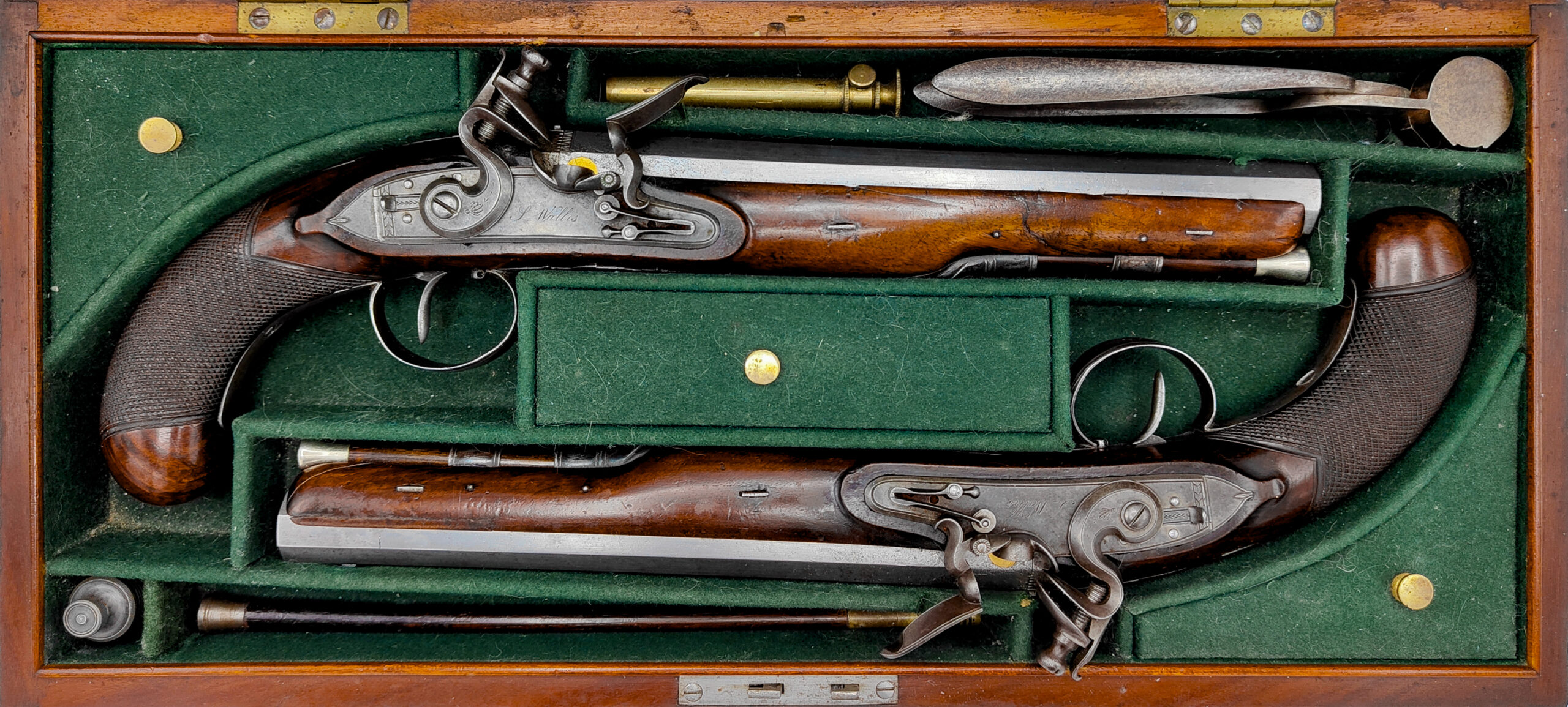From Flint Lock to Percussion Weapons
In the course of the 19th century, a significant transformation took place in weapon technology. The transition from flintlock to percussion lock improved the reliability and ease of use of pistols, ushering in a new era in firearm technology. Two outstanding historical pistol models illustrate this shift: a pair of English flintlock pistols by Stephen Wallis from Birmingham, made around 1820, and a pair of French percussion pistols by Duon from Nancy, made around 1850.

1. Flint Lock Pistols by Stephen Wallis (Birmingham, ca. 1820)
At the beginning of the 19th century, flintlock pistols were the prevailing technology. The flintlock mechanism, which had been in use since the 17th century, worked by generating sparks. When the trigger was pulled, a flint attached to the hammer struck a metal surface known as the battery. This strike produced sparks that ignited the powder in a side-mounted powder pan, which in turn ignited the main powder in the barrel, allowing the pistol to fire. However, this mechanism was prone to malfunction, particularly in damp weather, and required the shooter to be well-prepared and maintain the pistol with care.
An excellent example of the elegance and precision of English flintlock pistols is the pair crafted by Stephen Wallis around 1820 in Birmingham. These pistols are housed in an original mahogany case lined with green felt and feature a label with Wallis’s workshop address on Vauxhall Road, Birmingham. The pistols themselves have polished mahogany stocks, enhanced with checkering for a better grip, and engraved steel fittings characteristic of British craftsmanship of that period. A gilded touchhole framing and a ramrod with a silver cap are additional quality features that helped prevent misfires.
In addition to the pistols, the case includes a collection of accessories essential for the shooter: a powder flask, a bullet mold, an oil container, a powder measure, a cleaning rod, and a bullet starter. These items illustrate the extensive preparation needed for use (casting bullets, a multi-stage loading process, firing the weapon, etc.) and maintenance (cleaning after each shot, removing residues, addressing misfires, etc.) of a flintlock pistol. The fine workmanship showcases the quality of Birmingham gunmaking, though the tendency for misfires remained an issue, fueling demand for a more reliable mechanism.

2. French Percussion Pistols by Duon (Nancy, ca. 1850)
Starting around the 1820s, the percussion mechanism began to replace the flintlock. This new technology used a small metal cap, known as a percussion cap, filled with explosive mercury fulminate. When the trigger was pulled, the hammer struck this cap, causing a small explosion that ignited the powder in the barrel. This mechanism was not only more reliable and safer but also more resistant to weather, making it the preferred choice for shooters and militaries alike.
An elegant example of this new technology is the pair of French percussion pistols by Duon from Nancy, made around 1850. Housed in a high-quality rosewood case with red felt lining, these pistols reflect the sophisticated craftsmanship of their time. The pistols feature walnut stocks with finely worked checkering and floral-engraved steel fittings, which lend them a particularly refined appearance. The barrels are made of Damascus steel, a material known for its durability and attractive grain. Adorned with ornamental gold inlay, these pistols represent 19th-century French gunmaking artistry.
The case also contains extensive accessories essential for the care and use of the pistols: a powder flask shaped like a barrel, a bullet mold, a nipple wrench with various attachments that can be used as screwdrivers, a cleaning rod, a bullet starter, a loading mallet, and a round container for patches and caps.
Conclusion: Technological Advancements in Firearm Technology
The shift from the flintlock to the percussion mechanism marked a significant advancement in the reliability and user-friendliness of firearms. Stephen Wallis’s flintlock pistols from the 1820s represent the final stage before the widespread transition to the percussion mechanism, whose technical improvements and increased functionality are clearly demonstrated in Duon’s pistols. Additionally, a direct comparison reveals the simpler, more utilitarian design of English pistols alongside the finer, more artistic craftsmanship of French handguns and their accessories. Both pairs of pistols are not only valuable collector’s items but also fascinating witnesses to a technological shift that revolutionized firearm technology and defined a new era in the use of firearms.

